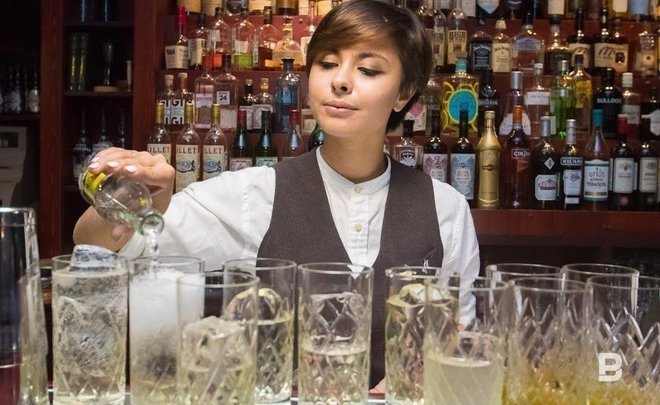Tatarstan ahead of most regions in sales of hard liquor. What's good about that?
Alcohol market experts explained why the growth of official sales of hard liquor in Tatarstan is good and forecasted whether prices will continue to rise

Retail sales of hard liquor in Tatarstan continue to creep up, overtaking most other Russian regions. According to the Federal Alcohol Regulation Service of the Russian Federation, almost 1 million decaliters of strong drinks were sold in all retail chains of the republic in the third quarter of 2021. This is the fourth result among 85 Russian regions, only Moscow, St. Petersburg and Moscow Oblast are ahead. Moreover, there is a positive point in this: “They drink about the same throughout Russia, but only the strong vodka regions — Tatarstan and Bashkortostan — drink legal alcohol," said Vadim Drobiz, the director of the Centre for Research of Federal and Regional Alcohol Markets (CIFRRA). Аrom December 15, retail prices for all types of alcohol may rise from 5% to 15%, he predicts.
How Tatarstan overtakes top five 'vodka' regions
Rosalkogolregulirovanie regularly publishes quarterly reports on the retail sales of alcoholic beverages in all regions of Russia. They contain exclusively 'store' sales of strong alcohol, which are automatically reflected in the EGAIS system, but at the same time “cleared” of HoReCa (sale of alcohol in bars and restaurants). Because of this, the retail section of the Rosalkogolregulirovanie is considered to be a marker of alcohol consumption among the population in different regions of the country.
Tatarstan, as it turned out, has regained its leadership in terms of strong alcohol sales among 85 regions, with the exception of Moscow, St. Petersburg and Moscow Oblast. According to the latest report of Rosalkogolregulirovanie, 906,8 thousand decaliters were sold in the entire retail network of the republic in the third quarter of 2021, which is by 10% more than a year ago. As a result, Tatarstan accounts for 3,5% of all-Russian alcohol sales. It is possible that in the next new year's quarter, retail sales will approach the pre-pandemic “degree”, when retail chains sold 930-950 thousand decaliters per quarter.
There are traditionally established “vodka” regions in Russia. Krasnodar Krai is slightly inferior to Tatarstan in their list, being the 2nd. 899,1 thousand decaliters of strong alcoholic beverages were bought here, which is by almost 15% more than last year (794,000 decaliters), follows from the report of Rosalkogolregulirovanie. This region accounts for 3,32% of the all-Russian market.
It is followed by Sverdlovsk Oblast (3,2%) and Bashkortostan (2,9%). Retail sales in Sverdlovsk Obalst rose to 865,8 thousand decaliters against 812,2 thousand for the same period last year, and in Bashkiria — up to 801 thousand against 760 thousand decaliters (all data are for the III quarter of 2021 — ed.).
Nizhny Novgorod Oblast rounds out the top six “alco favourites”, which accounts for 2,4% of the market, or 656 thousand decaliters. According to alcohol distributors, it is in these regions (except for megacities) alcohol markets are trying to gain a foothold in order to intensify the supply of a wide range of alcohol. In other regions, retail sales range from 300 to 600 thousand decaliters per quarter.
Tatarstan residents have begun to drink less vodka
By the way, about Tatarstan manufacturers. Against the background of rising demand, Tatspirtprom has increased its production. According to the company's press service, 6,3 million dal of alcoholic beverages were produced in the first 9 months of the year, of which 5,57 million dal accounted for vodka. At the same time, the pace of implementation is synchronous with production. According to the press service of Tatspirtprom, 6,2 million dal of drinks have been sold since the beginning of the year, 5,4 million dal of them are vodka.
However, Tatarstan buyers are changing their preferences. According to alcomarcet.info, since the beginning of the year, the volume of vodka sales in Tatarstan retail has decreased by 10% to 2 million dal. According to them, Belenkaya is replaced with cognac, whiskey, brandy. The Centre for Research of the Federal and Regional Alcohol Markets CIFRRA reported that the volume of vodka sales has fallen by 5,25%, but the sales of other beverages has increased. The sales of foreign whiskey, tequila, rum, brandy, which are in the high price category (from 1,000 rubles per bottle), showed a gigantic growth of 34,2%. Traditionally “women's” alcoholic beverages with a alcohol by volume of up to 20% began to be sold by 5,2% more, “men's” spirits — by 9%. And only the wine has sunk again, losing 3,7%.
“Vodka is no longer a fashionable drink," says a market insider. “The trend of reducing the consumption of strong drinks has not begun today, not yesterday. For the elite, there is now an incredibly huge offer for cognac and brandy.”
According to him, a large production of wines in the Crimea is being revived, which are not inferior in quality to Krasnodar. But in the mass segment, they are beginning to switch to cheap aperitifs, since vodka is not affordable for everyone.
“They drink about the same all over Russia”
Meanwhile, constant records of alcohol sales in Tatarstan are evaluated by market participants in different ways. Galina Sharafutdinova, the executive director of the Association of Restaurateurs and Hoteliers of Tatarstan, believes that people simply “went home to drink” because of the closure of bars and restaurants. He explains the change of taste preferences in such a way that they drink not in order “to just get drunk and forget”, but “to spend a good evening at home”.

According to him, Tatarstan belongs to the regions with a high standard of living, and where the salary is higher, the more legal alcohol is bought:
“Once in Russia they started making ratings 10 years ago, showing that here are regions with high alcohol consumption, they are 'bad'," he argues. “But in fact, it is necessary to interpret just the opposite. The 'worst' regions in this regard are those with low volumes of legal alcohol sales. This means that the consumption of illegal alcohol is high. Therefore, alcohol ratings need to be 'turned over'. On the one hand, Tatarstan and Bashkiria are theoretically, like, Muslim regions, but in fact, they are typically strong vodka regions. But Islam in Dagestan has an impact on retail trade — alcohol is not sold in stores there during Ramadan.”
The trend of decreasing demand for vodka, according to the expert, is not due to a change in tastes, but to the redrawing of the age demographic structure of the population.
“From the end of the 1990s to the beginning of the 2000s, half as many children were born in the country. Because of this, the beer market has fallen by a third, since 70% of beer is drunk by young people. Now those who were born in 2002-2004 come to the stores. And the decline of the beer market has stopped," Drobiz gave an example.
Strong alcohol is consumed mainly by men. According to the calculations of experts, there was also going to be a demographic crisis here, and consumption was supposed to fall by 1,5% a year. And it would have been falling if not for the pandemic.
Vadim Drobiz believes that forecasts of a sharp increase in prices by 20% will not come true:
“Strong alcohol has risen in price, as usual, within 5%. It has nothing else to grow from," he is sure. But wines can rise in price by 10%. Russian wine producers have a difficult situation. There is a terrible shortage of wine materials: imported material has been forbidden to use. But for imported wines, there is no reason for a rise in price.